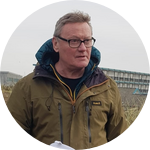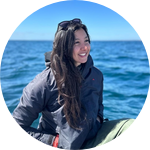About This Project
The purpose of this work is to determine which prey species contribute the most microplastics to the diet of the marine mammals inhabiting the coasts of Peninsula Valdes, and what happens to these particles once they enter the organisms. Understanding the dynamics of microplastics in marine mammals, considered sentinels of ecosystems, will allow us to assess the overall health status of the environment surrounding them.
Ask the Scientists
Join The DiscussionWhat is the context of this research?
In recent years, there has been a significant increase in plastic waste along the coasts of the Coastal Marine System of the Peninsula Valdes (CMSPV). Alongside the rise in waste, marine mammals have been repeatedly reported entangled in nets, ropes, lines and even trapped in large plastic pieces. Additionally, the ingestion of large plastic pieces as well as microplastics has been detected in cetaceans inhabiting the area. Although microplastics may seem insignificant due to their size, it has been demonstrated that they can translocate to various tissues of mammals and release sustances that may have a negative effect on the organism, such as endocrine disruption. This project proposes to analyze microplastics in the diet of marine mammals inhabiting the CMSPV.
What is the significance of this project?
The presence of microplastics has been reported in the gastrointestinal contents of common dolphins (Delphinus delphis) and southern right whales (Eubalaena australis) inhabiting the coast of the CMSPV. Through this project, we will be able to gather more information about the origin of microplastics reaching marine mammals, which prey species contribute the most, and what happens once they enter the organism. Having this information will help us understand the dynamic of microplastics in the study area and thus propose mitigation policies.
What are the goals of the project?
The general objective of this study is to evaluate the presence, bioaccumulation (persistence in the organism), biomagnification (higher concentration of contaminants in predators compared to their prey), and possible translocation (movement from the stomach to other organs) of microplastics in marine mammals inhabiting the CMSPV. To accomplish it, the gastrointestinal content of common dolphins (Delphinus delphis), southern right whales (Eubalaena australis), dusky dolphins (Lagenorhynchus obscurus) and american sea lions (Otaria flavescens) will be analyzed. This four species feed and reproduce in the study area.
Budget
Zooplankton samples will be taken in both Gulfs, the Golfo Nuevo and the Golfo San Jose. In this case, the budget includes the fuel for the boat, the fuel for the truck to transport the boat to the starting point, and payment to the boat captain. For sampling sea lion feces, the budget includes fuel, as it requires traveling long distances on more than one occasion. Sampling requires specific equipment for working with microplastics, minimizing cross-contamination (glass jars, metal equipment), and increasing biosecurity measures (gloves, face mask, others). To process the samples in the laboratory, other specific supplies and equipment is needed, like digestion reagents and glass fiber filters. After the inspection of the samples, a subsample of particles found will be analyzed using Raman spectroscopy to provide us with information about the chemical composition of the particles.
Endorsed by
 Project Timeline
Project Timeline
There will be two periods of fecal sampled, one in the cold season (July-August) and one in the warm season (October-November), in both gulfs. The prey of whales and sea lions will be sampling during the same period. Furthermore, samples of gastrointestinal content and various tissues from dolphins (dusky, common, orca) preserved in the laboratory will be analyzed. Since December to March, samples will be processed and analyzed. In April the results will be communicated.
May 15, 2024
Project Launched
Jul 01, 2024
Fecal and prey sampling (cold season)
Oct 01, 2024
Fecal and prey sampling (warm season)
Dec 01, 2024
Begin sample processing
Apr 01, 2025
Comunication of the results
Meet the Team
Team Bio
Advisors:
Dr Mariana Degrati. Specialist on dynamic and social structure of dusky dolphins groups (Lagenorhynchus obscurus) affected by anthropic activities in the Northpatagonic gulf.
Dr Valeria D'Agostino. Specialist on transfer of phycotoxins through the pelagic food webs and levels of exposure of marine mammals in Patagonia in a climate change scenario.
Dr Rodrigo Hernández Moresino. Specialist on dynamics of sediments and plastic contaminants in Golfo Nuevo.
Camila Tavano Formigo
I am a PhD student. I'm carrying on my project on the Laboratory of Marine Mammals (LAMAMA) in the Center for the Study of Marine Systems (CESIMAR) - National Council of Scientific and Technical Research (CONICET). In my undergraduate research, I investigated microplastic contamination in the diet of two cetacean species, the southern right whale (Eubalaena australis) and the common dolphin (Delphinus delphis), which inhabit the Golfo Nuevo in Argentine Patagonia. I analyzed the presence of this contaminant in their gastrointestinal tracts and compared it with microplastics found in their main prey (zooplankton and fish, respectively). Additionally, I refined isolation techniques for these samples. Currently, in my PhD research, I am continuing with the same topic, analyzing plastic pollution in the Coastal Marine System of Peninsula Valdes, focusing on marine mammals as bioindicator species.
Additional Information
The types of microplastics found in the marine mammals (composition, shape, color, and size) will be compared with those present in their main prey. Tissue samples from the stomach, intestine, blood, kidney, liver, among others, will be taken from deceased animals to analyze translocation to other organs. In the case of dolphin and sea lion prey, the liver, muscle, and digestive tract of fish, as well as the visceral mass in squids and octopuses, will be analyzed. Zooplankton samples will be taken for whale prey. Gastrointestinal content will be collected from stranded mammals. In the case of whales and sea lions, fecal samples will also be collected from live specimens. Whale fecal samples will be opportunistically collected during nautical sampling, and through the collaboration of whale watching guides operating in the area.
Project Backers
- 3Backers
- 111%Funded
- $4,340Total Donations
- $1,446.67Average Donation


